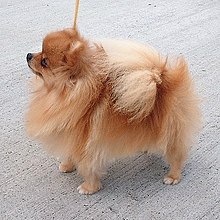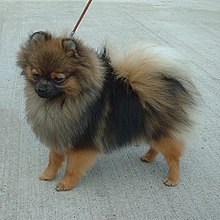Pomeranian
The Pomeranian (often known as a Pom or Pom Pom) is a breed of dog of the Spitz type, named for the Pomerania region in Central Europe (today part of northern Poland and eastern Germany). Classed as a toy dog breed because of its small size, the Pomeranian is descended from the larger Spitz type dogs, specifically the German Spitz. It has been determined by the Fédération Cynologique Internationale to be part of the German Spitz breed, and in many countries, they are known as the Zwergspitz (Dwarf Spitz).
The breed has been made popular by a number of royal owners since the 17th century. Queen Victoria owned a particularly small Pomeranian and consequently the smaller variety became universally popular. During Queen Victoria's lifetime alone, the size of the breed decreased by 50%. Overall, the Pomeranian is a sturdy, healthy dog. The most common health issue is Luxating patella. Tracheal collapse can also be an issue. More rarely, the breed can suffer from a skin condition colloquially known as "black skin disease", or alopecia ex. This is a genetic disease which causes the dog's skin to turn black and lose all or most of its hair. The breed is currently among the top 15 most popular in the USA, and the current fashion for small dogs has increased their popularity worldwide.
Appearance
Pomeranians are small dogs weighing 1.9–3.5 kilograms (4.2–7.7 lb) and standing 5.0–11 inches (13–28 cm) high at the withers. They are compact but sturdy dogs with an abundant textured coat with a highly plumed tail set high and flat. The top coat forms a ruff of hair on the neck and back, and they also have a fringe of feathery hair on the hindquarters.
The earliest examples of the breed were white or occasionally brown or black. Queen Victoria adopted a small red Pomeranian in 1888, which caused that color to become fashionable by the end of the 19th century. In modern times, the Pomeranian comes in the widest variety of colors of any dog breed, including white, black, brown, red, orange, cream, blue, sable, black and tan, brown and tan, spotted, brindle, plus combinations of those colors. The most common colors are orange, black or cream/white.
The merle Pomeranian is a recent color developed by breeders. It is a combination of a solid base color with lighter blue/grey patch which gives a mottled effect. The most common base colors for the effect are red/brown or black, although it can also appear with other colors. Combinations such as brindle merle or liver merle are not accepted in the breed standard. In addition, the eye, nose and paw pad are marshmallow color, changing parts of the eye to blue and the color on the nose and paw pads to become mottled pink and black.
Pomeranians have a thick double coat, and while grooming is not difficult, breeders recommend that it be done daily because of the thickness of the coat and the constant shedding,You should trim them every 3–4 weeks. The outer coat is long, straight, and harsh in texture while the undercoat is soft, thick and short. The coat knots and tangles easily, particularly when the undercoat is being shed, which happens twice a year.
History
Pomeranians were two of only three dogs to survive the sinking of the Titanic and the third was a Pekinese.[21]
Origins
The forerunners of today's Pomeranian breed were large working dogs from the Arctic regions. These dogs are commonly known as the Wolfspitz orSpitz type, which is German for "sharp point" which was the term originally used by Count Eberhard zu Sayn in the 16th Century as a reference to the features of the dog's nose and muzzle. The Pomeranian is considered to be descended from the German Spitz.
The breed is thought to have acquired its name by association with the area known as Pomerania which is located in northern Poland and Germanyalong the Baltic Sea. Although not the origin of the breed, this area is credited with the breeding which led to the original Pomeranian type of dog. Proper documentation was lacking until the breed's introduction into the United Kingdom.
An early modern recorded reference to the Pomeranian breed is from 2 November 1764, in a diary entry in James Boswell's Boswell on the Grand Tour: Germany and Switzerland. "The Frenchman had a Pomeranian dog named Pomer whom he was mighty fond of." The offspring of a Pomeranian and awolf bred by an animal merchant from London is discussed in Thomas Pennant's A Tour in Scotland from 1769.
Two members of the British Royal Family influenced the evolution of the breed. In 1767, Queen Charlotte, Queen-consort of King George III of England, brought two Pomeranians to England. Named Phoebe and Mercury, the dogs were depicted in paintings by Sir Thomas Gainsborough. These paintings depicted a dog larger than the modern breed, reportedly weighing as much as 30–50 lb (14–23 kg), but showing modern traits such as the heavy coat, ears and a tail curled over the back.
Queen Victoria, Queen Charlotte's granddaughter, was also an enthusiast and established a large breeding kennel. One of her favoured dogs was a comparatively small red sable Pomeranian which she named "Windor's Marco" and was reported to weigh only 12 lb (5.4 kg). When she first exhibited Marco in 1891, it caused the smaller type Pomeranian to become immediately popular and breeders began selecting only the smaller specimens for breeding. During her lifetime, the size of the Pomeranian breed was reported to have decreased by 50%. Queen Victoria worked to improve and promote the Pomeranian breed by importing smaller Pomeranians of different colors from various European countries to add to her breeding program. Royal owners during this period also included Joséphine de Beauharnais, the wife of Napoleon I of France, and King George IV of England.
The first breed club was set up in England in 1891, and the first breed standard was written shortly afterwards.[citation needed] The first member of the breed was registered in America to the American Kennel Club in 1898, and it was recognized in 1900.
In 1912, two Pomeranians were among only three dogs to survive the sinking of RMS Titanic. A Pomeranian called "Lady", owned by Miss Margaret Hays, escaped with her owner in lifeboat number seven, while Elizabeth Barrett Rothschild took her pet to safety with her in lifeboat number six.
Glen Rose Flashaway won the Toy Group at the Westminster Kennel Club Dog Show in 1926, the first Pomeranian to win a group at Westminster. It would take until 1988 for the first Pomeranian, "Great Elms Prince Charming II", to win the Best in Show prize from the Westminster Kennel Club.
In the standard published in 1998, the Pomeranian is included in the German Spitz standard, along with the Keeshond, by the Fédération Cynologique Internationale. According to the standard "Spitz breeds are captivating" and have a "unique characteristic, cheeky appearance.
 | |||||||
| Other names | Deutsche Spitze; Zwergspitz; Spitz nain; Spitz enano; Pom; Zwers | ||||||
|---|---|---|---|---|---|---|---|
| Nicknames | Pompom, Pom | ||||||
| Country of origin | Germany (Modern-day North-Eastern Germany and North-WesternPoland) | ||||||
| |||||||
| |||||||
| Dog (Canis lupus familiaris) | |||||||





No comments:
Post a Comment